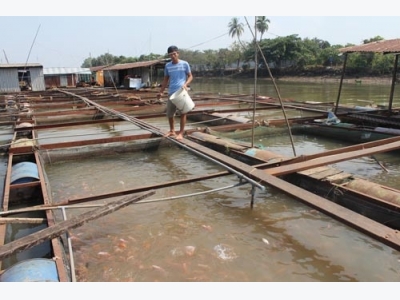How to Achieve Good Water Quality Management in Aquaculture
Water quality is the most important factor affecting fish health and performance in aquaculture production systems
 Water Quality in Aquaculture
Water Quality in Aquaculture In the Cuyahoga, dissolved oxygen levels in one study of fourteen sites ranged from 1.5 to 90 percent saturation, with an average of 13.2 percent. 100 percent
 Acute Hepatopancreatic Necrosis Disease Aetiology Epidemiology Diagnosis Prevention
Acute Hepatopancreatic Necrosis Disease Aetiology Epidemiology Diagnosis Prevention Acute hepatopancreatic necrosis disease (AHPND) emerged as a new disease of shrimp in 2010. The disease is sometimes referred to as early mortality syndrome
 How to reduce pH in Aquaponics without so much guess work
How to reduce pH in Aquaponics without so much guess work Where we are the tap water is literally “liquid rock” with high alkalinity coming out the tap at a pH of 8.2 to 8.5 depending on the time of year
 Erosion, Sedimentation in Earthen Aquaculture Ponds
Erosion, Sedimentation in Earthen Aquaculture Ponds Embankments made of heavy clay soils must have adequate side slopes or they will slip.
 Turbidity Removal From Pond Waters
Turbidity Removal From Pond Waters Eliminate sources of turbidity in culture ponds and use coagulants only if the turbidity remains.
 Simple Settling Chambers Aid Solids Management In Biofloc System
Simple Settling Chambers Aid Solids Management In Biofloc System A study that examined the effects of removing suspended solids using side-stream settling cham-bers in a superintensive biofloc shrimp system found the chambers
 Managing High pH in Freshwater Ponds
Managing High pH in Freshwater Ponds The term “pH” is a mathematical transformation of the hydrogen ion (H+) concentration; it conveniently expresses the acidity or basicity of water.
 Interactions of pH, Carbon Dioxide, Alkalinity and Hardness in Fish Ponds
Interactions of pH, Carbon Dioxide, Alkalinity and Hardness in Fish Ponds Water quality in fish ponds is af-fected by the interactions of sev-eral chemical components. Carbon dioxide, pH, alkalinity and hard-ness are interrelated
 Manage pH Cycles To Maintain Animal Health
Manage pH Cycles To Maintain Animal Health pH levels in ponds are affected by such factors as time of day, vegetation and aeration activity.
 Total Alkalinity, Total Hardness
Total Alkalinity, Total Hardness Proper management of phytoplankton in aquaculture ponds is important to maintain adequate water pH levels.
 Measuring Dissolved Oxygen Concentration in Aquaculture
Measuring Dissolved Oxygen Concentration in Aquaculture Dissolved oxygen concentration (DO) is considered the most impor-tant water quality variable in fish culture. In the broadest sense, how-ever, dissolved oxygen
 Dissolved Oxygen Management In Aquaculture
Dissolved Oxygen Management In Aquaculture Regular monitoring can identify changing D.O. levels and avoid stressful impacts on culture animals.
 Feeding Affects Pond Water Quality
Feeding Affects Pond Water Quality Since not all feed is consumed by the animals in aquaculture systems, careful feed application is called for.
 Measuring Circulation, Mixing in Ponds
Measuring Circulation, Mixing in Ponds Several methods for evaluating water circulation and mixing in aquaculture ponds are available to farm operators.
 Feed Efficiency Indicators for Responsible Aquaculture
Feed Efficiency Indicators for Responsible Aquaculture Environmentally responsible, profitable aquaculture has its foundation in efficient resource use. Feed usually is the most costly item in aquaculture production
 Lake, Reservoir Characteristics Affect Cage Culture Potential
Lake, Reservoir Characteristics Affect Cage Culture Potential Factors that include area, volume and flushing rates interact to affect water quality in lakes and reservoirs.
 Dissolved-Oxygen Requirements In Aquatic Animal Respiration
Dissolved-Oxygen Requirements In Aquatic Animal Respiration In aquatic animals, blood hemo-globin unloads oxygen to the tissue fluids. Coldwater species have higher dissolved-oxygen concentration requirements
 Drying, Liming, Other Treatments Disinfect Pond Bottoms
Drying, Liming, Other Treatments Disinfect Pond Bottoms Drying pond bottoms between cycles is the first step toward disinfection. Puddles and wet areas should receive lime or another effective treatment to eliminate
 Embodied Resource Use In Feed-Based Aquaculture
Embodied Resource Use In Feed-Based Aquaculture In life cycle analysis of aquaculture, there is a danger of the entire array of embodied resources and impacts being assigned to the production facility
